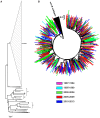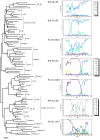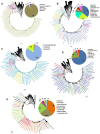Molecular epidemiology of HIV-1 in Panama: origin of non-B subtypes in samples collected from 2007 to 2013
- PMID: 24454808
- PMCID: PMC3890310
- DOI: 10.1371/journal.pone.0085153
Molecular epidemiology of HIV-1 in Panama: origin of non-B subtypes in samples collected from 2007 to 2013
Abstract
Phylogenetic studies have suggested that the HIV-1 epidemic in the Americas is mainly dominated by HIV subtype B. However, countries of South America and the Caribbean have recently reported changes in their circulating HIV-1 genetic profiles. The aim of this study was to characterize the molecular profile of the HIV-1 epidemic in Panama by the analysis of 655 polymerase gene (pol) sequences that were obtained from HIV-infected Panamanians diagnosed between 1987 and 2013. Blood samples were collected from recently infected, antiretroviral drug-naïve and treatment-experienced subjects since mid-2007 to 2013. Viral RNA from plasma was extracted and sequences of HIV protease and reverse transcriptase genes were obtained. Bootscanning and phylogenetic methods were used for HIV subtyping and to trace the putative origin of non-B subtype strains. Our results showed that HIV-1 infections in Panama are dominated by subtype B (98.9%). The remaining 1.1% is represented by a diverse collection of recombinant variants including: three URFs_BC, one CRF20_BG, and one CRF28/29_BF, in addition to one subtype F1 and one subtype C, none of which were previously reported in Panama. The non-B subtype variants detected in Panama were probably introduced from Brazil (subtype F1 and CRF28/29_BF), Cuba (CRF20_BG), Dominican Republic (URFs_BC) and India (subtype C). Panama is the geographical vertex that connects the North with South America and the Caribbean through trade and cultural relations, which may explain the observed introductions of non-B subtype HIV-1 variants from both the Caribbean and South America into this Central American country.
Conflict of interest statement
Figures




Similar articles
-
Analysis of HIV-1 pol sequences from Panama: identification of phylogenetic clusters within subtype B and detection of antiretroviral drug resistance mutations.Infect Genet Evol. 2009 Sep;9(5):933-40. doi: 10.1016/j.meegid.2009.06.013. Epub 2009 Jun 24. Infect Genet Evol. 2009. PMID: 19559103
-
The HIV-1 epidemic in Bolivia is dominated by subtype B and CRF12_BF "family" strains.Virol J. 2012 Jan 16;9:19. doi: 10.1186/1743-422X-9-19. Virol J. 2012. PMID: 22248191 Free PMC article.
-
Detection of distinct human immunodeficiency virus type 1 circulating recombinant forms in northeast Brazil.J Med Virol. 2011 Dec;83(12):2066-72. doi: 10.1002/jmv.22170. J Med Virol. 2011. PMID: 22012712
-
Country Level Diversity of the HIV-1 Pandemic between 1990 and 2015.J Virol. 2020 Dec 22;95(2):e01580-20. doi: 10.1128/JVI.01580-20. Print 2020 Dec 22. J Virol. 2020. PMID: 33087461 Free PMC article.
-
HIV-1 subtype frequency in Northeast Brazil: A systematic review and meta-analysis.J Med Virol. 2020 Dec;92(12):3219-3229. doi: 10.1002/jmv.25842. Epub 2020 Apr 28. J Med Virol. 2020. PMID: 32266997
Cited by
-
Identification of major routes of HIV transmission throughout Mesoamerica.Infect Genet Evol. 2017 Oct;54:98-107. doi: 10.1016/j.meegid.2017.06.021. Epub 2017 Jun 20. Infect Genet Evol. 2017. PMID: 28645708 Free PMC article.
-
HIV-1 Diversity and Drug Resistance in Treatment-Naïve Children and Adolescents from Rio de Janeiro, Brazil.Viruses. 2022 Aug 12;14(8):1761. doi: 10.3390/v14081761. Viruses. 2022. PMID: 36016383 Free PMC article.
-
Novel HLA class I associations with HIV-1 control in a unique genetically admixed population.Sci Rep. 2018 Apr 17;8(1):6111. doi: 10.1038/s41598-018-23849-7. Sci Rep. 2018. PMID: 29666450 Free PMC article.
-
Human immunodeficiency virus type 1 (HIV-1) subtype B epidemic in Panama is mainly driven by dissemination of country-specific clades.PLoS One. 2014 Apr 18;9(4):e95360. doi: 10.1371/journal.pone.0095360. eCollection 2014. PLoS One. 2014. PMID: 24748274 Free PMC article.
-
Drug resistance in children and adolescents with HIV in Panama.J Antimicrob Chemother. 2023 Feb 1;78(2):423-435. doi: 10.1093/jac/dkac407. J Antimicrob Chemother. 2023. PMID: 36454248 Free PMC article.
References
-
- (2011) Boletín estadístico 2010. República de Panamá: Departamento de Registros y Estadísticas de Salud. Dirección Nacional de Planificación. Ministerio de Salud. pp. 113.
-
- Teva I, Bermudez MP, Ramiro MT, Buela-Casal G (2012) [Current epidemiological situation of HIV/AIDS in Latin America: Analysis of differences among countries]. Rev Med Chil 140: 50–58. - PubMed
-
- Comisión Nacional para la Prevención y Control del VIH SIDA C (2009) Plan Estratégico Nacional Multisectorial de ITS VIH y Sida 2009-2014. Panama: Programa Nacional de ITS VIH y SIDA. Ministerio de Salud de Panamá. 1–108 p.
-
- Castillero JR (2011) Diagnóstico de Redes Regionales y Nacionales, Organizaciones y Grupos en formación que realizan proyectos y actividades dirigidas a la prevención y/o atención del VIH con población PEMAR. República de Panamá: Programa de USAID para fortalecer la respuesta centroamericana al VIH (USAID/ PASCA).
-
- Reeves WC, Cuevas M, Arosemena JR, De Lao SL, Gomez B, et al. (1988) Human immunodeficiency virus infection in the Republic of Panama. Am J Trop Med Hyg 39: 398–405. - PubMed
Publication types
MeSH terms
Associated data
- Actions
- Actions
- Actions
- Actions
- Actions
- Actions
- Actions
LinkOut - more resources
Full Text Sources
Other Literature Sources
Medical
Molecular Biology Databases
Miscellaneous

